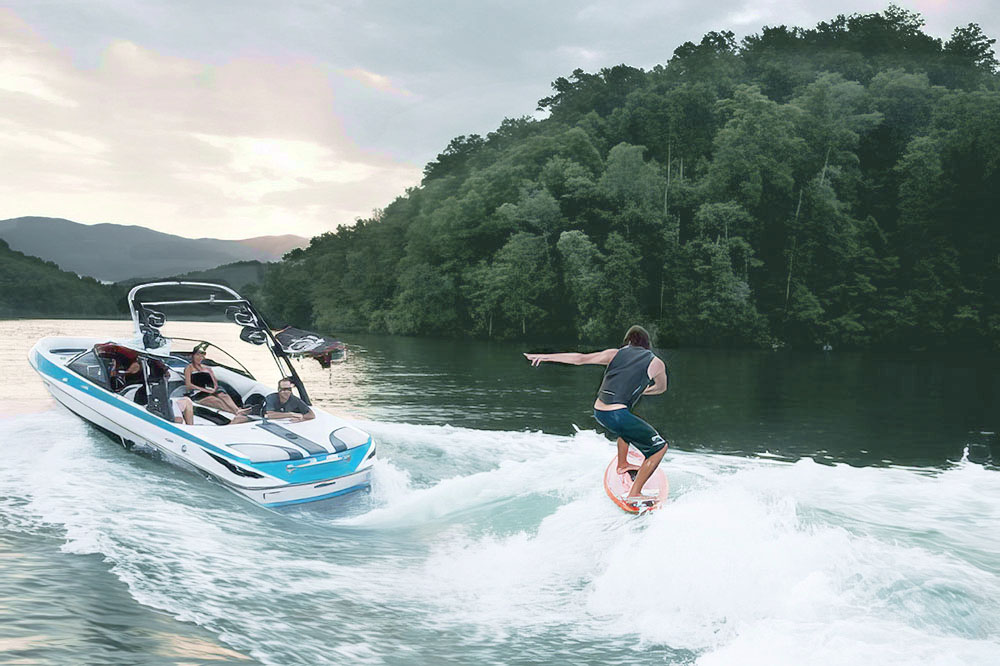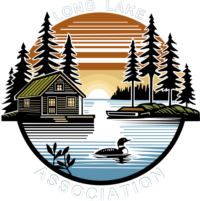Wake Boat Info
Wake Boat Controversy
Wisconsin is advocating for a state law to prohibit wake-enhanced boating on lakes smaller than 1,500 acres and within 700 feet of shore. Such a statute would allow wake boat activity on an estimated 77 lakes in Wisconsin.
Wake Boats are boats specifically designed to create large wake, the wake is being used by riders for a more intense experience allowing a surfboard to be propelled forward.
Wake Boarding is similar to water skiing where a tow rope is used.
Wake Surfing: some use a tow rope, some do not. The wake propels rider forward.
Ballast tanks are used which are filled and discharged with water, to enable certain performance characteristics. Typical boats will have 200-500 gallons of ballast tank capacity.

Wake Boat Waves- collateral damage identified from recent studies
a. Shoreline Erosion
b. Vegetation damage from uprooted plants to depths of 17 feet, takes years to reverse.
c. Sediment stirred up causing algae blooms
d. Shore nesting birds upended
e. Invasive species can be introduced to lakes from ballast tanks that can not be drained properly.
Wisconsin Bills Currently in the Senate
1. Bill AB656 (Assembly) was brought to the floor 11-09-23 and referred to the Committee on Forestry Parks and Outdoor Recreation.
This bill regulates wakesurfing and wakeboarding. The bill defines wakesurfing as surfing a motorboat’s wake, regardless of whether the person is being pulled by a tow rope attached to the motorboat that is producing the wake or operating a motorboat in a manner that creates a wake that is, or is intended to be, surfed by another person. The bill defines wakeboarding as being towed on a board with or without foot bindings by a motorboat across the vessel’s wake or operating a motorboat in a manner that creates a wake while towing a person on a board with or without foot bindings.
Under current law, various regulations apply to water skiing, aquaplaning, “or similar activity,” and under current law, wakesurfing and wakeboarding likely fall under “aquaplaning” or “similar activity.” The bill explicitly provides that “aquaplaning” includes wakesurfing and wakeboarding, and thereby applies the same safety regulations that apply to water skiing and aquaplaning to wakesurfing and wakeboarding. These regulations include requiring an observer or a wide-angle mirror on the motorboat, restricting wakesurfing and wakeboarding to between sunrise and sunset, prohibiting intoxicated wakesurfing and wakeboarding, requiring a motorboat used for wakesurfing or wakeboarding to stay more than 100 feet away from any occupied anchored boat, personal watercraft, or marked swimming area or public boat landing, and prohibiting a person engaged in wakesurfing or wakeboarding from being within 100 feet, or allowing a tow rope to be within 100 feet, of a personal watercraft.
The bill also adds restrictions that apply specifically to wakeboarding and wakesurfing. Current law prohibits the operation of a motorboat on a lake open to public access that is 50 acres or less. The bill prohibits wakesurfing and wakeboarding on a body of water of 50 acres or less or that is less than 400 feet wide, regardless of public access. The bill prohibits wakesurfing or wakeboarding within 200 feet of a shoreline or dock, pier, boathouse, or other structure located completely or partly on the water, though the bill allows a local ordinance to be less strict, but not more strict, than this prohibition. The bill also requires that a person surfing a wake or being towed on a board must wear a personal flotation device. The bill applies the same penalties to wakesurfing and wakeboardingviolations that apply to water skiing violations under current law.
2. Bill SB680 (Senate) it was read on 11-15-23 and referred the Committee on Financial Institutions and Sporting Heritage.
This bill regulates wakesurfing and wakeboarding. The bill defines wakesurfing as surfing a motorboat’s wake, regardless of whether the person is being pulled by a tow rope attached to the motorboat that is producing the wake or operating a motorboat in a manner that creates a wake that is, or is intended to be, surfed by another person. The bill defines wakeboarding as being towed on a board with or without foot bindings by a motorboat across the vessel’s wake or operating a motorboat in a manner that creates a wake while towing a person on a board with or without foot bindings.
Under current law, various regulations apply to water skiing, aquaplaning, “or similar activity,” and under current law, wakesurfing and wakeboarding likely fall under “aquaplaning” or “similar activity.” The bill explicitly provides that “aquaplaning” includes wakesurfing and wakeboarding, and thereby applies the same safety regulations that apply to water skiing and aquaplaning to wakesurfing and wakeboarding. These regulations include requiring an observer or a wide-angle mirror on the motorboat, restricting wakesurfing and wakeboarding to between sunrise and sunset, prohibiting intoxicated wakesurfing and wakeboarding, requiring a motorboat used for wakesurfing or wakeboarding to stay more than 100 feet away from any occupied anchored boat, personal watercraft, or marked swimming area or public boat landing, and prohibiting a person engaged in wakesurfing or wakeboarding from being within 100 feet, or allowing a tow rope to be within 100 feet, of a personal watercraft.
The bill also adds restrictions that apply specifically to wakeboarding and wakesurfing. Current law prohibits the operation of a motorboat on a lake open to public access that is 50 acres or less. The bill prohibits wakesurfing and wakeboarding on a body of water of 50 acres or less or that is less than 400 feet wide, regardless of public access. The bill prohibits wakesurfing or wakeboarding within 200 feet of a shoreline or dock, pier, boathouse, or other structure located completely or partly on the water, though the bill allows a local ordinance to be less strict, but not more strict, than this prohibition. The bill also requires that a person surfing a wake or being towed on a board must wear a personal flotation device.
The bill applies the same penalties to wakesurfing and wakeboarding violations that apply to water skiing violations under current law.
3. LRB5069/1 (Legislative Reference Bureau) proposed by Senator Andre Jaque. December 9, 2023
This bill restricts the operation of a motorboat causing a hazardous wake, which the bill defines as a boat wake the height of which is intentionally amplified through the use of ballast, boat design features, or operational procedures. The bill prohibits such operation on a lake smaller than 1,500 acres, and less than 700 feet from the shoreline or from any boat, swimmer, or other water user on a lake that is
1,500 acres or larger.
Long Lake
Our lake is 251 acres. Our lake is long and narrow. Our widest spot in the lake is about 1700 ft, which is only a small portion of the lake. Our deepest spot is about 40 ft deep, most of our lake is less than 20 feet deep.
Here is a good article covering exactly what LRB5069/1 is addressing from the Wildlife Management Institute. In their December issue found at www.wildlifemanagement.institute09
